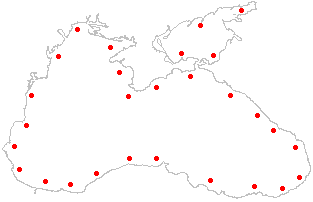
Acipenser güldenstaedti (Brandt, 1833)

Synonyms: Acipenser güldenstaedti Berg, 1911; Acipenser güldenstaedti var. colchicus Marti, 1940; Acipenser güldenstaedti colchicus Berg, 1948.
Common names: Engl: Russian sturgeon; Bulg: Ruska esetra; Rom: Nisetru; Russ: Russkiy osetr; Turk: Karaca; Ukr: Oseter.
Order (Scientific): ACIPENSERIFORMES.
Family (Scientific): ACIPENSERIDAE.
Taxonomic descriptions: Subcylindrical and elongate body with large bony scutes arranged in 5 raws; one in the middle of the back, one pair on the sides and another pair on the belly; a pair of large triangular bonny scutes on the isthmus, beneath the head; the mouth placed beneath the head is small, transverse and can be protected as a short tube; gill membranes joined to the isthmus, thus not forming a free fold; lower lip interrupted in the mid-line snout blunt and short, barbels on the underside of the snout, not reaching the mouth and inserted on a transverse row nearer to the tip of the snout than to the mouth; colour of the back and sides variable from grayish-black to dark green, belly whitish. Size: maximum - 210 cm; common - 110-145 cm (males), 130-170 cm (females).
 IUCN Status:
IUCN Status:
World level:
Black Sea Regional level:
Subregion level: VU
Distribution:
Habitats type, Critical habitats, Limiting factors: Mainly coastal waters of the sea and rivers; enters the Don, Kuban, Dniepr, Danube and rivers of the Caucasian coasts of the Black Sea. Spends the winter in the zone with Mytilus and Modiolus biocoenosis (at 60-70 m depths). Abundant in the Azov Sea, also occurring in the Caspian Sea; absent in the Mediterranean Sea.
Biology: Feeds mainly on molluscs, crustaceans and fishes. Migratory anadromous species; in spring (February-May) enters the rivers and in autumn (August-November) in the sea on the hibernation grounds. During the spawning run the fish move separately or in small shoals. The Sexual maturity at 8-12 years (male) and 13-15 years (female); after reproduction, adults come back to the sea.
Population trends: Caught with drift and stake net, long lines and beach seines. In June 1903 - March 1904 in front of the Sf.Gheorghe branch 85,160t were caught , and in the Portita zone 60,175 kg; compared with the 1920-1940 period, the catches of this species diminished by 80% in 1940-1960; in front of the Danube mouths, the catches recorded for July-October of this period represented hundred tons/year; in 1989 - 19,000 t; in 1990 - 4,000 t and in 1991 - 15,000 t; for the 1993-1994 period, there were estimated (for the North-West zone of the Black Sea) stock of 3,300,000 specimens, 180,000 of them exploitable.
Threats: Overfishing, large hydraulic projects which block traditional migration routes and access to spawning areas.
Conservation measures taken: Development of experimental research concerning the artificial reproduction and growing of fry. This species is under the protection in Turkey since 1997. Total catch was 110 tons in 1995. A special recovery and monitoring programme was started by the Turkish Marine Research Foundation in Sakarya and Kizilirmak estuaries.
Conservation measures proposed: Respecting the feeding sites of the fry from the Danube mouths; interruption of fishing with pound nets during the great agglomerations of fry (July-August); protection of spawners during migrations and spawning times (April-July); production of fingerlings and populating the Danube river. Adoption of strict national measures to reduce poaching; fisheries under strict international control.
References:
Compiled by: A.Petranu, B.Öztürk.